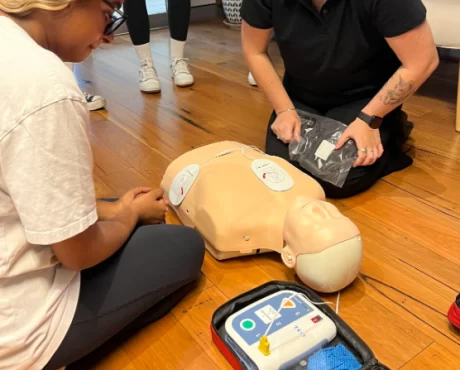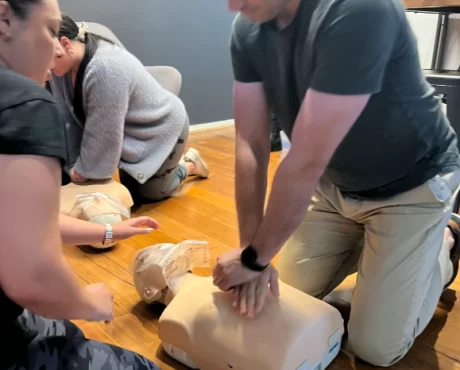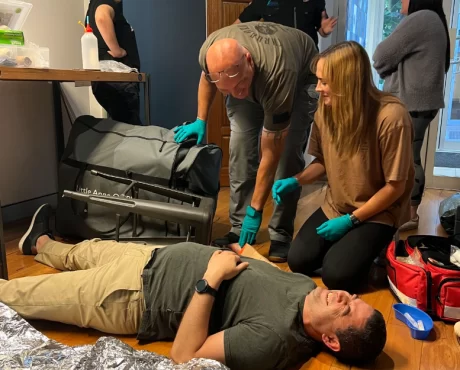About Us
Australia’s leading life-safety experts, united by one mission: protecting people.
Trusted specialists delivering capability, confidence, and emergency readiness nationwide.
David Gilmore
Director
David is an Emergency Planning Specialist at EvacServices, supporting organisations nationwide with compliant, practical, and people-focused emergency preparedness. He has designed and certified Emergency Plans for government, commercial, industrial, and major private-sector clients, including Investa, Knight Frank, RMIT University, CSU, CBRE, and Red Bull. With strong expertise in stakeholder engagement and process improvement, David helps organisations build confidence, capability, and peace of mind through effective emergency planning.
Duncan Graham
CEO
Duncan is a people-driven executive with a deep passion for life safety, emergency readiness, and protecting communities. With 24 years leading large, high-performing teams across multiple sectors, he brings a strong record in operational excellence, human-centred design, and transformational change. At EvacServices, Duncan’s focus is building trusted partnerships, elevating safety culture, and ensuring organisations are confident and prepared to respond to emergencies. His leadership continues to drive innovation, capability development, and measurable improvements in safety outcomes across Australia.
Romaine Ngo
Head of Service and Infrastructure
Romaine is a dedicated technology professional with over 13 years’ experience delivering high-reliability systems and service excellence. With a background in legal technology and practice management solutions, he brings strong capability in infrastructure, process optimisation, and customer-centred innovation. At EvacServices, Romaine oversees the platforms and service delivery that support life-safety compliance nationwide, ensuring our clients receive seamless, dependable and scalable solutions. Known for his empathetic leadership style, he fosters learning, adaptability, and high-performing teams that keep emergency readiness running smoothly.
Hugh McCurley
Head of Delivery
Hugh is a seasoned security and emergency management executive with over 30 years’ experience across national security, federal law enforcement, and critical infrastructure protection. At EvacServices, he brings unmatched expertise in threat readiness, public order management, and emergency training design. Hugh is passionate about building confidence and capability in organisations, translating complex risk into clear, actionable response strategies. Known for his calm leadership and practical approach, he helps clients strengthen life-safety culture and prepare teams to respond decisively under pressure.
Amy Latt-Dermody
Head of Projects
Amy is a skilled Head of Projects who plays a critical role in ensuring the high-quality delivery of evacuation diagrams and emergency plans at EvacServices. She oversees the workflow of our offshore technical team, manages project timelines, and maintains the accuracy and compliance of all outputs. With strong attention to detail and a passion for continuous improvement, Amy ensures every project meets Australian standards and client expectations. Her structured, proactive approach keeps our national service delivery seamless and efficient.
Jerome Cruz
Finance Manager
Jerome is an experienced finance leader with over a decade of expertise across corporate accounting, financial analysis, and commercial reporting. Before joining EvacServices, he held senior finance roles at Sentinel Property Group, Mazars, and several multinational accounting practices. As Finance Manager, Jerome ensures the financial strength, governance and sustainability that underpin EvacServices’ life-safety mission. Known for his analytical capability and steady leadership, he supports data-driven decisions that help our operations, clients, and teams perform with confidence and reliability.
Vision & Values
Vision
To be the provider of choice in Emergency Management empowering organisations and communities to stay safe, compliant, and confident through education, innovation, and care.
Mission
To educate and empower people to save lives by delivering clear, compliant, and practical emergency management solutions. We support, train, and coach our team to be knowledgeable and add value, deliver on client expectations, and strive for simplicity, efficiency, and excellence in everything we do.
Our Core Values
Excellence
• Strive to do our best
• Deliver on commitments and expectations
• Open to learning and improving
Versatility
• Open minded for change
• Prepared to jumping into action
• Think and do on your feet
Accountability
• Always treating people with respect
• Take responsibility for actions
• Doing what’s right – ethically and morally
• Take responsibility for actions
• Doing what’s right – ethically and morally
Courage
• Being safe and respected to speak up
• Having a crack
• Back yourself to have a go
• Having a crack
• Back yourself to have a go
Fun
• Embrace culture, diversity and inclusivity
• Determination to enjoy where we work
• Team events continue
• Determination to enjoy where we work
• Team events continue














Why Our Clients Love to Work with Us!
Emily was the best trainer I have had deliver this training in the 3.5 years I have worked here. She was engaging and to the point, without missing critical information. I have had wonderful feedback from multiple staff already. We would love to retain her for future sessions, please.
Kevin was great, informative, organised and on point
Wouldn't change anything - Rudy (EvacServices Consultant) who performed the training was excellent - he is a credit to your organisation.
Liked that the training suited our needs here within the shopping centre. Thank you covered what we needed at our experience level.
We attended Warden training yesterday facilitated by Ben. The training was the best Evac training we have ever attended. Bens’s facilitation style created a positive and collaborative atmosphere, making the topic both interesting and fun while delivering critical information.
Trusted by

Ready to Take the Next Step?
Let EvacServices assess your facility and guide you toward full compliance with zero guesswork.


